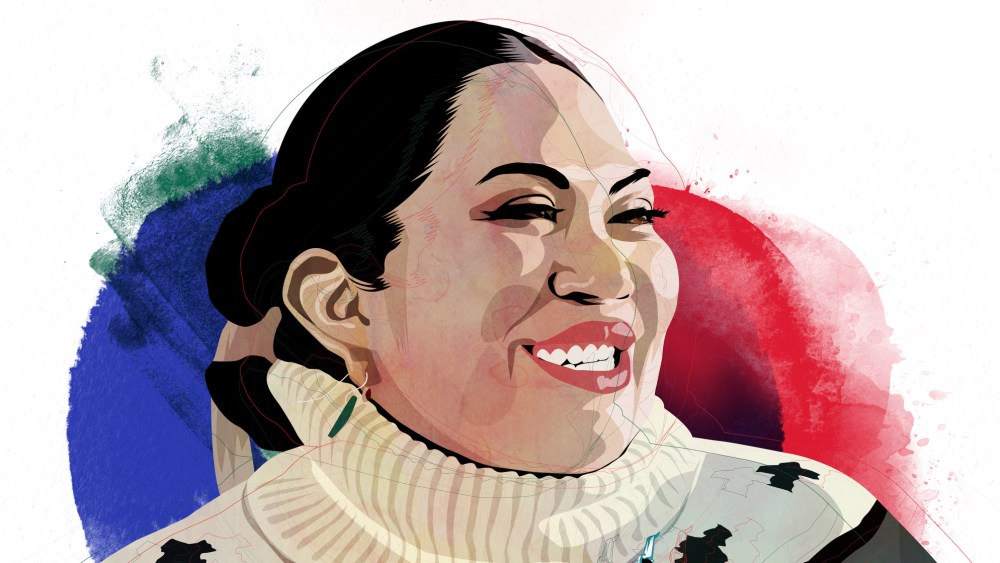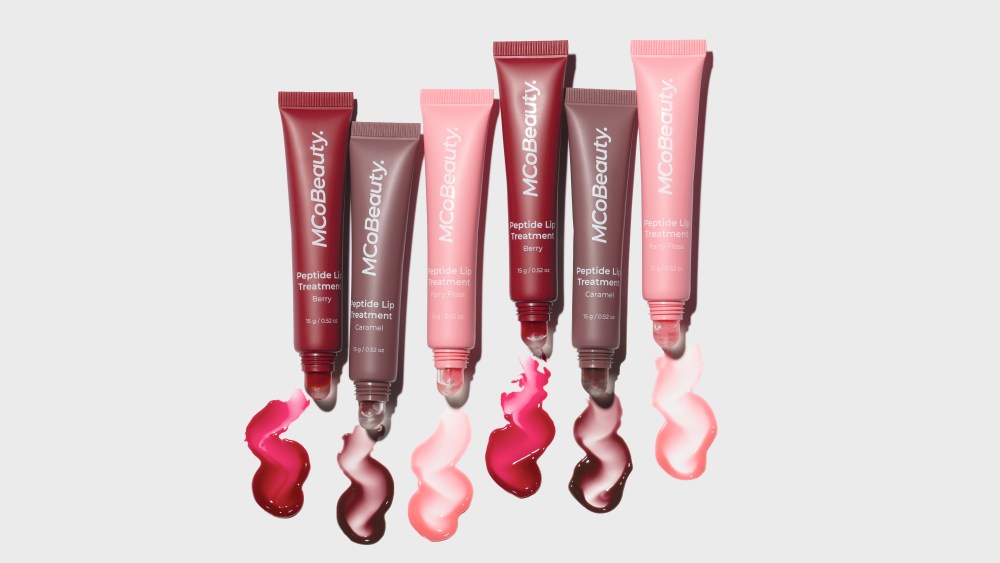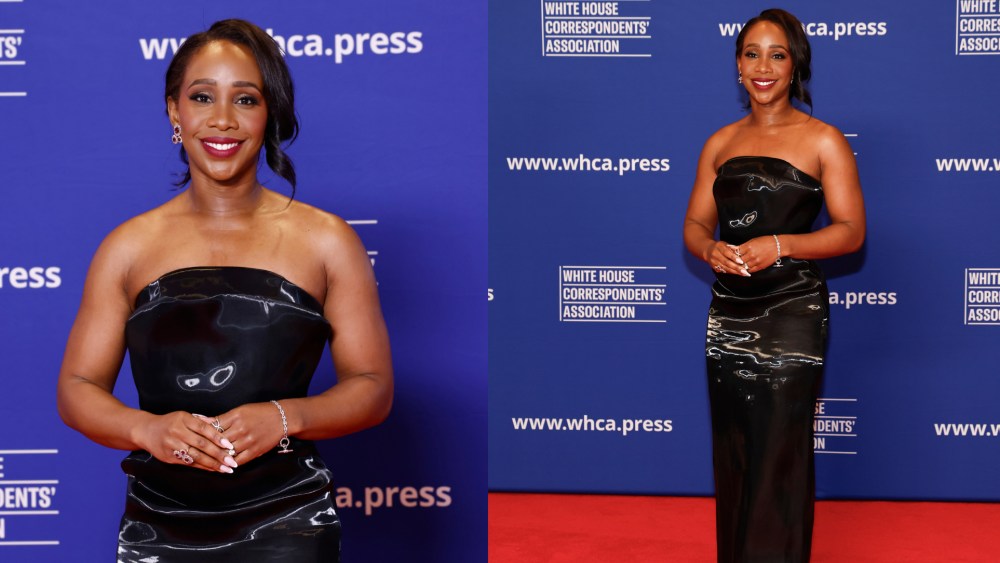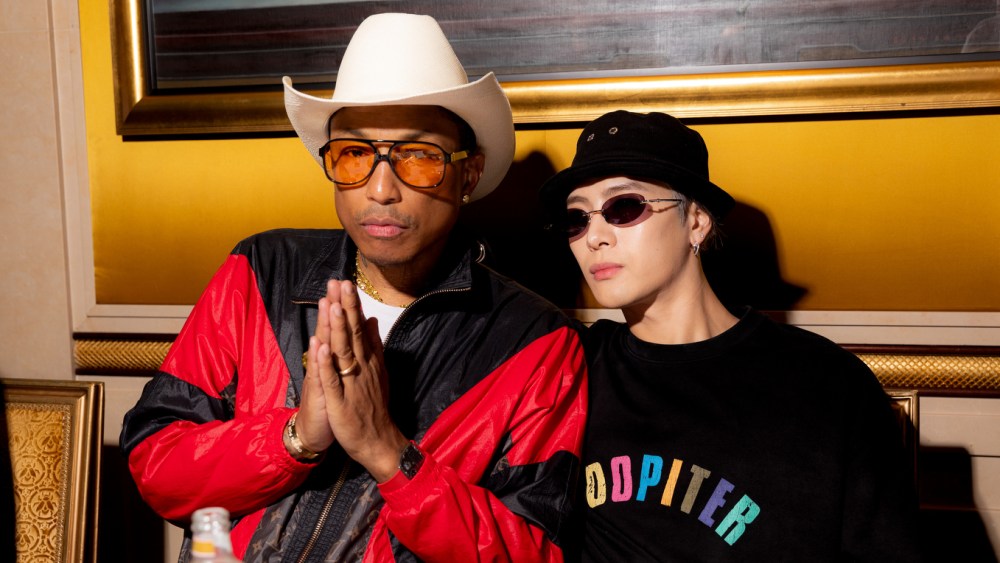The crowd was spilling out the doors of Malouf on the Plaza on the eve of the 2024 Santa Fe Indian Market in Santa Fe, N.M,. in August. Inside the fashion, textile and jewelry store, Diné (Navajo) weaver Naiomi Glasses was being pulled in all different directions by customers shopping her “Denim Daydream” Polo Ralph Lauren collection, asking her for selfies, autographs even.
“In my 50 years of retail, I’ve never seen anything like it, not even for Giorgio Armani,” said Scott Malouf, who sells works by Indigenous artists and jewelers alongside high-end sportswear brands and first started selling Glasses’ work about eight years ago “because we had no weavers under 70 years old,” he joked.
You May Also Like
“The Santa Fe person who follows Native art was ready for it, the Indigenous community was ready for it, and the turnout of young up-and-coming artists and her circle of influence was incredible . . . . Everyone was ready for this breakthrough moment,” he said of the long-overdue respect for Indigenous inspiration in fashion and the milestone cocreated Polo collection.
Everyone was ready for Glasses’ breakthrough talent, too. Her extraordinary textile designs and their translations to clothing through the Ralph Lauren Artist in Residence program, her personal style, social media (and skateboarding!) savvy, and her ability to inspire others make her the ideal choice for this year’s WWD One to Watch Honor.
“It was my first Santa Fe market with a big release under my belt,” said Glasses, 27, a seventh-generation weaver from Rock Point, Ariz., on the Navajo Nation, of the experience. “So many people were coming up telling me how inspirational this was and how they wish there had been something like this when they were growing up — and how they loved Ralph Lauren as a brand but this made them love it even more.”
Glasses’ three collections with the Artist in Residence program, released from December 2023 through August 2024, brought her traditional cross and striped weaving motifs to denim, tailoring, sportswear, knitwear and accessories, while touching on the common love she and Ralph Lauren share for horses, rugged workwear and family. Many of the pieces have sold out within hours, as they did at Malouf.
“I’ve seen photos from people’s Christmas parties or gatherings and there are some families where they all have the sweaters,” Glasses said of how Indigenous communities have embraced the collection. “But the most memorable sighting was when I saw someone just randomly wearing a Great Ranch coat when we were in New York driving over the Brooklyn Bridge. I rolled down window and screamed.”

It was kismet that Glasses was tapped by Ralph Lauren to be the first Artist in Residence, part of the brand’s ongoing journey to shift to collaboration with communities that have historically inspired its designs.
She’s been a fan of the brand for as long as she can remember. “My mom always dressed me in polos and Polo dresses, and I remember going to the Ralph Lauren store at the Phoenix Biltmore, and seeing all the turquoise jewelry and thinking how cool it would be to curate a collection of jewelry there,” she said.
She also remembers seeing designs at the store that “looked like something I’d seen my grandma weave,” as she said. “When I was younger, I thought it was cool, but as I grew up, I realized they are not working with us and how cool it would actually be if they could keep that aesthetic but actually work with Indigenous artists.”
Glasses weaves alongside her brother Tyler, continuing a tradition they learned from their grandmother, Nellie. “I love the traditional wearing blanket and the older pieces,” she said, explaining that it is a personal choice for Indigenous artists whether they reference traditional culture in their work or not.
Many of the designs now associated with Navajo weaving were influenced by what traders wanted in the late 1800s and early 1900s, and based off of things like Persian rugs, Glasses told WWD. But her designs predate those to focus on original designs, many of which have dwindled over the years.

“What we as Diné used to weave back before the trading posts came in and influenced our way of weaving [were] a lot of motifs like four-directional crosses and Spider Woman crosses. For me, the four-directional cross is representative of the four directions and how in Navajo culture we hold four as a sacred number,” she said. The Spider Woman cross also pays homage to the deity from creation stories who taught the Diné how to weave.
Growing up, her dad owned a general contracting business, and her mom was the southwest marketing manager at Verizon Wireless; they instilled in her a work ethic, she said, and are usually by her side at events. “They might not be creative in what they do, but they were the ones who told us if you’re gonna get serious about weaving, you’re going to have to treat it like a business.”
Her rugs and bags, which take months to weave and can cost in the thousands and tens of thousands of dollars, were already a hit with market crowds in the Southwest before she became Internet famous in 2021. A TikTok video recorded by her brother of her skateboarding on a red sandstone slope, while wearing a traditional long, flowing skirt, turquoise jewelry and sneakers, went viral and was picked up by CBS News, Teen Vogue and other outlets.
“We started posting to show our rugs . . . taking photos of them in beautiful places around our home where the sheep graze, to show the inspiration connected to the land. And then one day, I said maybe I should get some photos of me skating. I posted them on Instagram, and people were like — ‘And you skate?!’ It was great.”

The same year, Glasses applied for a program with Creative Futures Collective, which works to empower creatives from disenfranchised and underrepresented communities. The organization introduced Glasses to the Ralph Lauren team after she expressed interest in fashion design and in Ralph Lauren specifically, which led to the three-drop collaboration.
“We’d been following along in the space to try to understand what a respectful cultural collaboration would look like, and who potentially would have a design vernacular or a design handwriting that would really fit well within our company aesthetic, but also look like something fresh and new,” said Sasha Kelly, head of the Ralph Lauren Design With Intent department that is working with experts and across all the brands to create cultural collaboration pathways.
“We’d also been attending SWAIA [Santa Fe Indian Market] and other art shows, and following a lot of the Indigenous press,” she said, pointing to Christian Allaire, an Ojibwe fashion writer at Vogue who has written about a number of Indigenous creatives. “We’d seen in one of Christian’s stories Naiomi’s work and her jewelry collection, both of which really run true to the style and aesthetic at Ralph Lauren.
“Her stories and her Instagram posting, too, was quite prolific in terms of her love of family and her love of horses and rodeo. So there was a lot of commonality of threads with our brand DNA. And then when we met Naiomi, she was and is a delight and it really felt like a good fit,” said Kelly, noting that the brand wanted to make sure not to overly influence her as an artist, but rather to incorporate what she does into pattern and print.

There were no ground rules, echoed Glasses, who started her research in the brand’s library in New York, which has been updated in recent years as part of the Design With Intent initiative. Certain archival pieces are now watermarked with the history of where the pieces came from, “understanding that in order to be inspired by them, we’ll do working cultural collaborations,” Kelly explained of respecting the original sources.
Glasses worked across the whole company to bring her weavings and design motifs to ready to wear and accessories. The marketing campaigns and videos were shot on the Navajo Nation by a Native crew, featuring Native talent as well as the artist’s friends and family. An avid jewelry collector herself, Glasses also curated turquoise and silver jewelry from six artisan families from the Navajo Nation, Hopi Pueblo, San Felipe Pueblo and Zuni Pueblo to style with the clothes, and sell in Ralph Lauren stores and on RalphLauren.com. “I thought this could help so many other families,” she said of choosing to work with contemporary rather than vintage jewelry.
A highlight of her time at 650 Madison was meeting Ralph. “It was just like meeting a friend and that’s not what I was expecting because . . . the man, the myth, the legend,” she said. “But it was incredible because we were able to just talk. And we started talking about rodeo somehow, and how he likes to go to one near his house in Colorado. He made me feel so at ease and at home.”
The two also had a similar personal style, a mix of old and new, traditional heritage with contemporary sport that is so Naiomi and so Ralph Lauren.

Now that she’s become well known not only for her art and fashion, but for being a cleft advocate, speaking around the country about her experience with a cleft lip and palate, Glasses has been traveling a lot for personal appearances, which leaves precious little time for weaving.
But she has lots of ideas.
“I’ve been sitting on this idea of making a woven jacket, weaving each different panel,” she said. “I also want to do a Navajo rug dress and a wearing blanket and matching purse to enter in a show.”
She’d also like more commercial opportunities, after her experience working with Ralph Lauren, weaving some pieces for Gabriela Hearst’s spring 2022 collection before that, and collaborating with blanket company Sackcloth & Ashes.

“I like being able to design things more people can have . . . to put my designs in more homes, in more hands,” Glasses said. “I can talk to more people about the art form of a seventh-generation weaver and about the culture and how we as Indigenous people are here.”
There is an appetite for more from her.
“We only sold out in two hours what I thought would last me through Christmas,” said Malouf, the Santa Fe retailer. “It’s a look that could translate to home decor, home accessories, fabrics, interior design fabrics. It has a lot applications. I think she’s the real deal.”
Glasses believes her increasing visibility, alongside other Indigenous creatives in fashion and in Hollywood, is leading to more understanding and appreciation of Indigenous culture. “We’re a part of the movement. In my lifetime, I saw major cultural appropriation growing up and now we’re collaborating and it’s really beautiful seeing that shift.”
And she wants to be sure to pay it forward. A portion of sales from each of the three Polo Ralph Lauren x Naiomi Glasses drops has gone to benefit nonprofits of her choice, the most recent one being Creative Futures Collective.
“She’s definitely on a path to something great . . . I could see her starting something because she is entrepreneurial in spirit, but I also see the creative director/collaborator in her where she could pick incredible companies to work with. She’s hands-down our biggest success story,” said Creative Futures’ cofounder Jai Al-Attas.
“I would love to see more Indigenous designers at New York Fashion Week. I remember how excited I felt seeing that Jamie Okuma and Josh Tafoya were brought into the Council of Fashion Designers of America,” Glasses said. “We need to have more of that to where it’s just another designer being added into the CFDA.”



